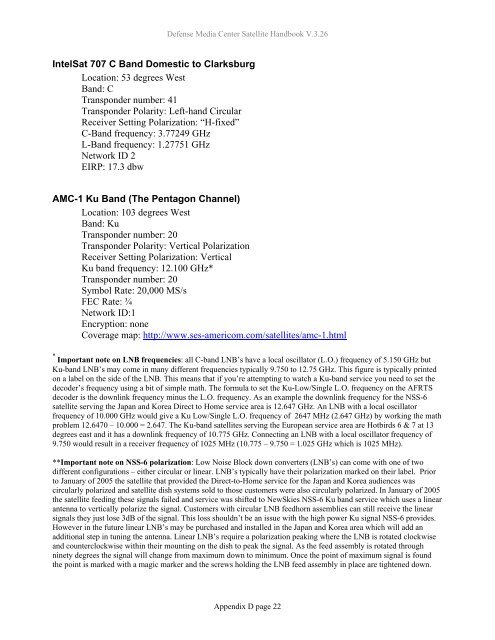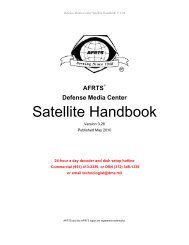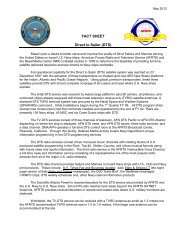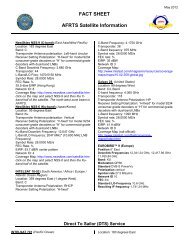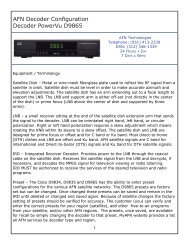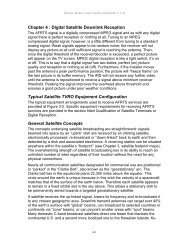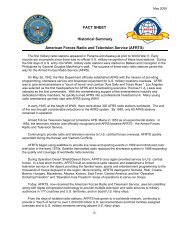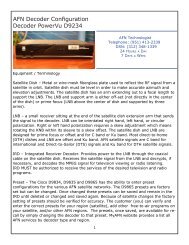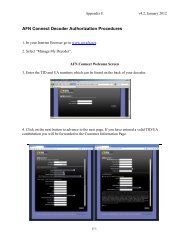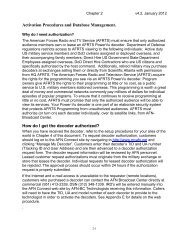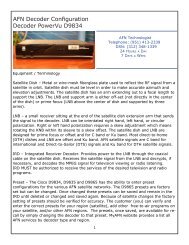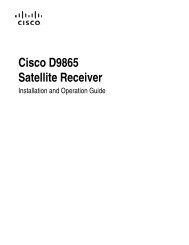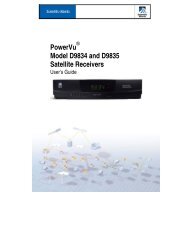AFRTS Defense Media Center Satellite Handbook
AFRTS Defense Media Center Satellite Handbook
AFRTS Defense Media Center Satellite Handbook
You also want an ePaper? Increase the reach of your titles
YUMPU automatically turns print PDFs into web optimized ePapers that Google loves.
<strong>Defense</strong> <strong>Media</strong> <strong>Center</strong> <strong>Satellite</strong> <strong>Handbook</strong> V.3.26<br />
IntelSat 707 C Band Domestic to Clarksburg<br />
Location: 53 degrees West<br />
Band: C<br />
Transponder number: 41<br />
Transponder Polarity: Left-hand Circular<br />
Receiver Setting Polarization: “H-fixed”<br />
C-Band frequency: 3.77249 GHz<br />
L-Band frequency: 1.27751 GHz<br />
Network ID 2<br />
EIRP: 17.3 dbw<br />
AMC-1 Ku Band (The Pentagon Channel)<br />
Location: 103 degrees West<br />
Band: Ku<br />
Transponder number: 20<br />
Transponder Polarity: Vertical Polarization<br />
Receiver Setting Polarization: Vertical<br />
Ku band frequency: 12.100 GHz*<br />
Transponder number: 20<br />
Symbol Rate: 20,000 MS/s<br />
FEC Rate: ¾<br />
Network ID:1<br />
Encryption: none<br />
Coverage map: http://www.ses-americom.com/satellites/amc-1.html<br />
* Important note on LNB frequencies: all C-band LNB’s have a local oscillator (L.O.) frequency of 5.150 GHz but<br />
Ku-band LNB’s may come in many different frequencies typically 9.750 to 12.75 GHz. This figure is typically printed<br />
on a label on the side of the LNB. This means that if you’re attempting to watch a Ku-band service you need to set the<br />
decoder’s frequency using a bit of simple math. The formula to set the Ku-Low/Single L.O. frequency on the <strong>AFRTS</strong><br />
decoder is the downlink frequency minus the L.O. frequency. As an example the downlink frequency for the NSS-6<br />
satellite serving the Japan and Korea Direct to Home service area is 12.647 GHz. An LNB with a local oscillator<br />
frequency of 10.000 GHz would give a Ku Low/Single L.O. frequency of 2647 MHz (2.647 GHz) by working the math<br />
problem 12.6470 – 10.000 = 2.647. The Ku-band satellites serving the European service area are Hotbirds 6 & 7 at 13<br />
degrees east and it has a downlink frequency of 10.775 GHz. Connecting an LNB with a local oscillator frequency of<br />
9.750 would result in a receiver frequency of 1025 MHz (10.775 – 9.750 = 1.025 GHz which is 1025 MHz).<br />
**Important note on NSS-6 polarization: Low Noise Block down converters (LNB’s) can come with one of two<br />
different configurations – either circular or linear. LNB’s typically have their polarization marked on their label. Prior<br />
to January of 2005 the satellite that provided the Direct-to-Home service for the Japan and Korea audiences was<br />
circularly polarized and satellite dish systems sold to those customers were also circularly polarized. In January of 2005<br />
the satellite feeding these signals failed and service was shifted to NewSkies NSS-6 Ku band service which uses a linear<br />
antenna to vertically polarize the signal. Customers with circular LNB feedhorn assemblies can still receive the linear<br />
signals they just lose 3dB of the signal. This loss shouldn’t be an issue with the high power Ku signal NSS-6 provides.<br />
However in the future linear LNB’s may be purchased and installed in the Japan and Korea area which will add an<br />
additional step in tuning the antenna. Linear LNB’s require a polarization peaking where the LNB is rotated clockwise<br />
and counterclockwise within their mounting on the dish to peak the signal. As the feed assembly is rotated through<br />
ninety degrees the signal will change from maximum down to minimum. Once the point of maximum signal is found<br />
the point is marked with a magic marker and the screws holding the LNB feed assembly in place are tightened down.<br />
Appendix D page 22


